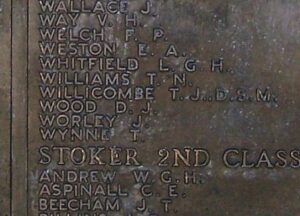The peaceful village of Llangadog is situated in the Towy Valley, south of Llandovery. There seems to be no single main War Memorial at Llangadog, but there is a WW2 plaque inside St. Cado’s Church and two plaques at Gosen Chapel to commemorate its members who fell during World War One and World War Two. There is another Church at nearby Gwynfe, but I do not know if there are any war memorials in there. Because I have identified several men and one woman from Llangadog who fell during both wars but are not commemorated on any of the aforementioned memorials, this page is an amalgam of all. Wouldn’t it be nice if one day, with the help of Lottery money perhaps, a memorial could be erected for the village?
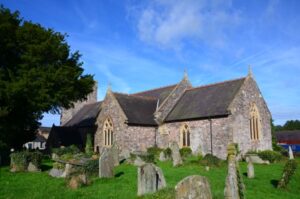
The Great War, 1914-1918
John Henry Culling, Private, 12261, Royal Welsh Fusiliers. John was the son of Alfred and Mary Culling, of 4, Dover Terrace, York Road, East Cowes, Isle of Wight. He worked as a Waggoner at Llanddeusant prior to the war and enlisted at Ammanford into the 8th Battalion, Royal Welsh Fusiliers. The battalion was attached to 40 Brigade, 13th (Western) Division, and was sent to the Mediterranean. The division landed at Gallipoli in July 1915, and saw heavy fighting before being withdrawn to Egypt in January 1916. John was then transferred to the 10th Battalion, Royal Welsh Fusiliers, which was in France attached to 76 Brigade, 3rd Division. He had only been in France for several weeks when he was seriously wounded at Ypres, and died of his wounds at Remi Sidings on 18 February 1916, aged 24. John is buried in Lijssenthoek Military Cemetery, Belgium. He does not appear to be commemorated locally.
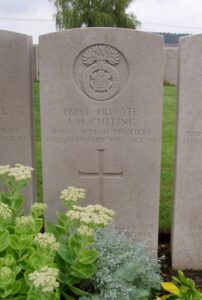
Gwilym Mansel Pritchard Davies, Rifleman, A/204035, London Regiment. Gwilym was the only son of Thomas Rhys Davies and Mag Hopkins Davies, of The Tonn, Llanon, Cardiganshire. The family later moved to Bryn Derwen, Llangadog. Gwilym was educated at Bristol and Aberystwyth Universities, and served for a time as a Certificated Teacher. He enlisted at Neath into the 12th Battalion (The Rangers), the London Regiment, which moved to France in December, 1914. On 8 February 1915 they joined 84 Brigade, 28th Division, and fought at Second Ypres. On 12 February 1916 they moved to become part of 168 Brigade, 56th Division, and fought at Gommecourt, and the Somme Battles of 1916. The Division followed the German withdrawal to the Hindenburg Line in March, 1917 before fighting at the Scarpe during the Arras Offensive. They then fought at Third Ypres and Cambrai, and on 31 January 1918 transferred to 175 Brigade, 58th Division and met the German Spring Offensive in the St. Quentin sector. The Division remained in the area, fighting during the Battles of Villers-Brettoneux and Amiens, when the German offensive was halted. Gwilym was wounded around this period, and Died of Wounds on 24 August 1918, aged 29. He is remembered on the Vis-En-Artois Memorial, France. Gwilym does not appear to be commemorated locally.
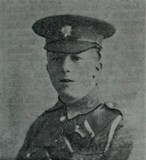
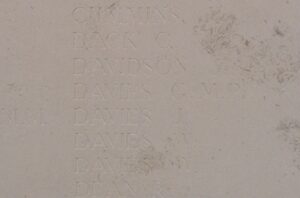
Thomas Davies, Private, 242011, Welsh Regiment. Thomas was born at Llangadog in 1888, and was the Foster son of Mrs. Mary Evans, of Cwoncaemawr, Cwmgam Road, Brynamman. He enlisted at Brynamman into the 18th Battalion, the Welsh Regiment, which were attached to 119 Brigade, 40th Division. They moved to France during June, 1916, serving near Loos until October, when it moved to the Somme, where they fought at the Ancre. They then followed the German withdrawal to the Hindenburg Line in March, 1917. Their next major action was during the Battle of Cambrai in November and December, 1917, and they were still in the area when the German Spring Offensive hit on 21 March 1918. They moved north to Flanders, and were hit again by the German attack on Estaires, and Thomas was Killed in Action during the chaotic days that followed, on 10 April 1918. He was 29 years old, and his body was lost in the continued fighting over the coming battles, and so he is remembered on the Ploegsteert Memorial, Belgium.
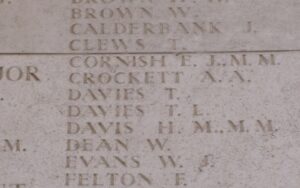
Baron Alan Frederick James de Rutzen, Lieutenant, Pembroke Yeomanry. Alan was born near Llangadog in 1876, the son of Sir Albert de Rutzen and Horatia Augusta Stepney de Rutzen. In 1908 he married Eleanor Etna Audley Thursby-Pelham, and the couple resided at Picton Castle and Glanmarlais Park. Alan joined the Pembroke Yeomanry at the outbreak of war, and went to Egypt with them in March 1916. He volunteered to serve with the Imperial Camel Corps, which had initially been formed as a raiding force, to counter the threat of hostile Senussi Tribesmen. Alan led the 6th Company, Imperial Camel Corps, and was killed during an engagement against the Turks near Katia on 7 August 1916, aged 40. He is buried at Kantara War Memorial Cemetery, Egypt. His only son, Alan, was killed during World War Two. Alan does not appear to be commemorated at Llangadog, but at Minwear, Pembrokeshire.

Gwynne Rhys Edmunds, Lieutenant, Royal Welsh Fusiliers. Gwynne was born in London in 1896, the son of Emily Edmunds. Emily was from Llandeilo, and prior to the war had moved the family back to Barons Court, Llangadog. On 3 May 1915 Gwynne was commissioned into the 18th Battalion, Royal Welsh Fusiliers, but was later attached to the 2nd Battalion, Royal Welsh Fusiliers, which had been in France since September 1914 as part of 19 Brigade. The battalion had fought at Mons, Le Cateau and the retreat to the Marne and the Battle of the Aisne. On 12 October the Brigade transferred to the 6th Division and fought at Hooge, east of Ypres, where they transferred to the 27th Division on 31 May 1915. Here they fought at Second Ypres, and then transferred again, to the 2nd Division on 19 August 1915, and fought with them at Loos, and then on 25 November transferred yet again, to the 33rd Division. The 2nd RWF then moved to the Somme, taking up positions at Fricourt. The battalion fought at the Battle of Albert, the opening battle of the Somme Offensive, on 1 July 1916, taking part in the capture of Mametz Village. It moved back into the line after a brief rest, and took part in the attacks on High Wood. This is where Gwynne was killed in action on 20 July 1917, aged 20. He is remembered on the Thiepval Memorial, France. (Gwynne is commemorated on the Gosen Chapel Memorial).
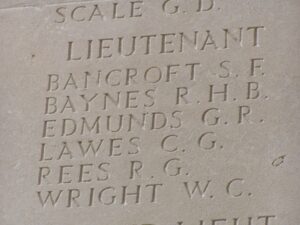
William Edwards, Rifleman, 3247, Rifle Brigade. William was born on 20 December 1885, the son of John William and Sarah Edwards, of 6, King Edward’s Road, Swansea. His mother Sarah was the daughter of David Lewis, of Llangadog, and William spent a lot of time with his maternal family during school holidays. He worked as a warehouseman prior to the war and enlisted at Swansea into the Rifle Brigade on 16 September 1914. He was posted to the 13th Battalion, Rifle Brigade, which was attached to 111 Brigade, 37th Division and landed in France on 31 July 1915. The division took part in the Attack on the Gommecourt Salient on 1 July 1916, during the first phase of the Battle of the Somme. Two of the Division’s infantry Brigades were then attached to the 34th Division, which had suffered heavy losses in the attack on La Boiselle, for several weeks, before the 37th Division was reconstituted. It then took part in the Battle of the Ancre, and wintered on the Somme before moving to Arras in March 1917. William was killed in action during the battle of Arras, on 23 April 1917, aged 29. He is buried in Point-Du-Jour Military Cemetery, Athies, France. He does not appear to be commemorated locally.
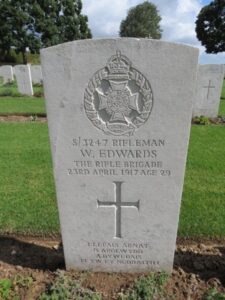
David Isaac Griffiths, Corporal, 46134, Machine Gun Corps. David was the son of David and Catherine Griffiths, of Goleugoed, Llangadog. He left the village to join the London and Provincial Bank in London, before transferring to their Aberdare Branch. At the outbreak of war he enlisted at Aberdare into the Oxfordshire & Buckinghamshire Light Infantry, where he became a Battalion Machine Gunner. On 2 September 1915, a proposal was made to the War Office for the formation of a single Machine-gun Company per Brigade, by withdrawing the guns from the Battalions. They would be replaced at Battalion level by Lewis guns. The Machine Gun Corps was created by Royal Warrant on 14 October 1915, followed by an Army Order on 22 October, and the MGC would consist of infantry machine-gun Companies, cavalry machine-gun Squadrons, and Motor Machine Gun Batteries. The pace of reorganisation depended on the rate of supply of Lewis guns, but it was completed before the Battle of the Somme. David by then had transferred into the 8th Company, Machine Gun Corps, which was attached to the 3rd Division; in time to take part in the opening battle of the Somme Offensive the Battle of Albert. They then fought at the Battle of Bazentin, where they captured Longueval, and advanced on to Delville Wood. In November the Division fought at the Battle of the Ancre, and saw the Somme Offensive out to a close. In the following year, the Battle of Arras was launched, and the 3rd Division fought at the Battle of the Scarpe. This is where David was killed in action on 10 April 1917, aged 25. He is remembered on the Arras Memorial, France. David is commemorated at Myddfai but not at Llangadog.
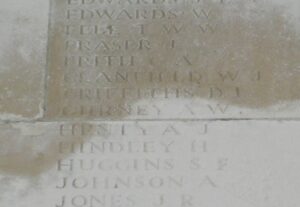
Rees Harries, Private, 84818 Machine Gun Corps. Rees was the son of Rees and Anne Harries, of Currey Cottage, Llangadog. He enlisted at Cardiff into the Welsh Regiment, where he became a Battalion Machine Gunner. On 2 September 1915, a proposal was made to the War Office for the formation of a single Machine-gun Company per Brigade, by withdrawing the guns from the Battalions. They would be replaced at Battalion level by Lewis guns. The Machine Gun Corps was created by Royal Warrant on 14 October 1915. The reorganisation was completed before the Battle of the Somme, which is when Rees transferred into the 9th Company, Machine Gun Corps, which was attached to the 3rd Division The division fought at the Battle of Bazentin, where they captured Longueval, and advanced on to Delville Wood. In November the division fought at the Battle of the Ancre, and saw the Somme Offensive out to a close. In the following year, the Battle of Arras was launched, and the 3rd Division fought at the Battle of the Scarpe. Rees survived the Scarpe and the Battles of Arras in 1917, and took part in the Battles of Third Ypres. After the fighting in Ypres was closed down, the Division moved to take part in the Battle of Cambrai, which is where Rees was wounded. He died of wounds on 26 November 1917, aged 28, and is buried at Favreuil British Cemetery, France. (Rees is commemorated on the Gosen Chapel Memorial).
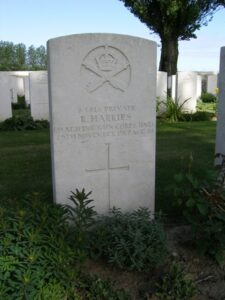
David Rees Jones, Private, 202925, South Lancashire Regiment. David was the son of Joshua and Martha Jones, of Ysguborwern, Gwynfe, Llangadog. He enlisted at Cardiff into the 2/4th Battalion, South Lancashire Regiment, which was part of 172 Brigade 57th Division. The Division moved to France in February, 1917, and saw its first major action at the Second Battle of Passchendaele. This is where David was wounded. He died of wounds on 11 September 1917, aged only 19, and is buried at Estaires Communal Cemetery Extension, France. David does not appear to be commemorated locally.
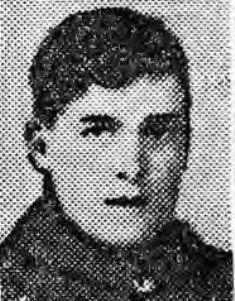
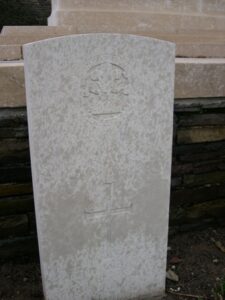
Henry Jones, Private, 474271, Canadian Infantry. Henry was born at Llangadog on 21 July 1884, the son of William and Gwenllian Jones. His parents later moved to Bank-y-Gwin, Llandeilo, and Henry emigrated to Canada prior to the outbreak of war. He enlisted at Saskatoon on 3 April 1916 into the 72nd Battalion (British Columbia), Canadian Infantry, which was part of 12 Brigade, 4th Canadian Division. Henry would have arrived in France in time to take part in the Divisions first battle at Le Transloy, on the Somme, in October 1916. They then fought at the Battle of the Ancre Heights, where the Canadians captured Regina Trench, before taking part in the Battle of the Ancre. Henry was wounded in action at the Battle of the Ancre, and Died of Wounds on 16 November 1916, aged 32. He is buried in Aveluy Communal Cemetery Extension, France. (Henry is commemorated on the Gosen Chapel Memorial). Many thanks to Lynn Armstrong for the photograph of Henry’s portrait.
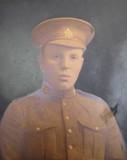
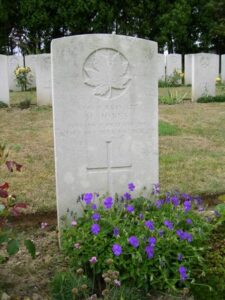
James Thomas King, Private, 59879 Machine Gun Corps. James was born at Lambeth in 1879, the son of Thomas Henry King. He came to work at Aberllechach, Llangadog around the turn of the century, and married Mary Ann Jones of Llangadog in 1901. By 1911 the couple were residing at 6, Gorsddu Road, Waunfawr, Penygroes, with five children. James enlisted at Llangadog into the Welsh Regiment. After the formation of the Machine Gun Corps, James transferred into the 15th Battalion, which was attached to the 15th (Scottish) Division, which had fought in France since July, 1915. James fought with the Division at the Battles of Pozieres and Le Transloy during the Somme Offensive and also during the Battle of Arras in 1917. They fought later in the year at Third Ypres, and were rushed to the Somme during the March, 1918 German Offensive. It was during that awful period on the Somme that James was killed in action, on 23 July 1918, aged 39. He is buried at Buzancy Military Cemetery, France. James does not appear to be commemorated locally.
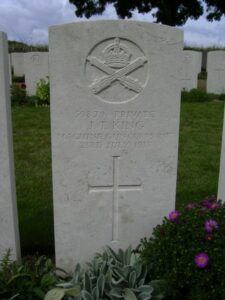
Rees Levi, Lance Corporal, 351953, Royal Scots. Rees was born in Llangadog in 1891 the son of John and Annie Levi. By 1911 the family had moved to Ratcliffe House Farm, Ratcliffe Culey, Atherstone, Warwickshire. Rees enlisted at Leicester into the Leicestershire Regiment, but later transferred into the 9th Battalion, Royal Scots, which were attached to 46 Brigade, 15th (Scottish) Division. The Division had fought in France since July 1915, and saw their first action at the Battle of Loos. Rees then fought with the Division at the Battles of Pozieres and Le Transloy during the Somme Offensive and also during the Battle of Arras in 1917. They fought later in the year at Third Ypres, and were rushed to the Somme during the March 1918 German Offensive. The tide of war had turned, after the famous 8 August 1918 victory at Villers-Brettoneux, the Allies went on the offensive, and swiftly moved towards, and took, the mighty Hindenburg Line. Rees was killed after this, during the final advance in Artois, on 19 October 1918, aged 27 and is buried at Cambrin Military Cemetery, France. Rees does not appear to be commemorated locally.
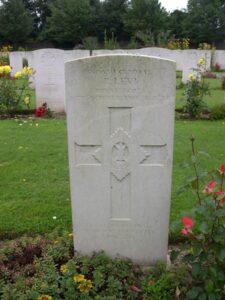
Benjamin Thomas Lewis, Private, 56784, Welsh Regiment. Benjamin was the son of Elias and Bridget Lewis, of Glandyrfal, Llangadog, and enlisted at Llandovery into the 14th Battalion, the Welsh Regiment, which was attached to 114 Brigade, 38th (Welsh) Division. The Division had been in France since landing during December, 1915, and had fought in Flanders, on the Somme at Mametz Wood, and then at Third Ypres, and in 1918 were rushed from their winter post of Armentieres to aid with the desperate defence of the Somme area, based around Albert. Benjamin was killed in action near Albert, during the attacks on Longueval on 27 August 1918, aged 22, and is buried at Caterpillar Valley Cemetery, Longueval, France. Benjamin does not appear to be commemorated locally.
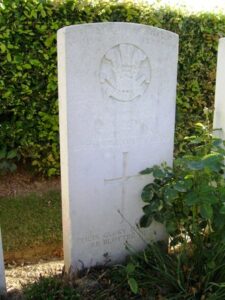
Margaret Lloyd Lewis, Ward Assistant, British Red Cross. Margaret was the wife of Walter Tudor Lewis, of the Post Office, Llangadock and the daughter of Alderman Edward Hughes, of Bootle, Merseyside. At the outbreak of war, a Red Cross Hospital was set up at Llandovery by Mrs Pryse-Rice, and Margaret volunteered on 24 December 1914 to work there as a Ward Assistant. She continued working there continually until falling ill during October 1916, when she was released from her duties. Margaret died following her exertions at the hospital, on 25 January 1917, aged 37. She was buried at Llangadog Churchyard in a ceremony which was attended by hundreds of people. Margaret is not commemorated by the CWGC, and is not commemorated locally.
Wymond Howard Lloyd, Second Lieutenant, Herefordshire Regiment. Wymond was the eldest son of Howard Meiric Lloyd and Aimee Lloyd (nee Peel), of Delfryn, Carmarthenshire. He was educated at Malvern and New College, Oxford, where he had completed two years’ residence. He rowed for his college in the second eight, and was a member of the O.U.O.T.C. He joined the Herefordshire Regiment as a second lieutenant in September 1914, before proceeding to his degree and studying for the Civil Service. He went with his regiment to Gallipoli in August 1915, and was five weeks at Suvla before contracting enteric and dysentery, from which he was recently convalescent after many weeks in hospital. He was engaged on light duty and hoped to pass for active service at a forthcoming medical board on, but died on 19 March 1916 at the Cottage Hospital, Oswestry, having been accidentally injured the previous afternoon. He was 23 years of age. The colonel commanding a Welsh division grouped depots, T.F., writes:- “Your son was a very fine young officer, and had gained the love and respect of all who came into contact with him, both in Gallipoli and here. I regret his loss personally, for I know what good work he was doing here in the training of the men”. Wymond is not commemorated at Llangadog, but at Talley, even though he was buried at Llangadog Churchyard on 23 March 1916.
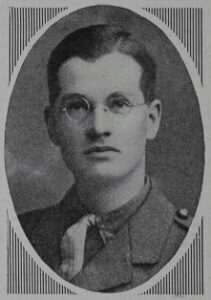
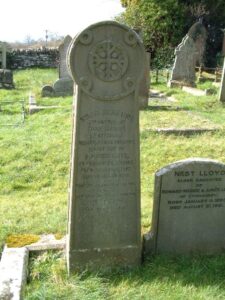
Daniel Thomas, Private, S/3227, Rifle Brigade. Daniel was born at Gwynfe, the son of Isaac and Margaret Thomas. His parents later resided at Pleasant Hill Capel Hendre, Pantyffynon. Daniel married Margaret Anne Edwards on 16 June 1908, and the couple set up home at Spen Cottage, Penygroes, where their son Vincent was born. Daniel enlisted at Abertridwr on 8 September 1914 into the Rifle Brigade. On 29 July 1915 Daniel was posted to France, joining the 13th Battalion, Rifle Brigade, which was attached to 111 Brigade, 37th Division. The division saw its significant action during the diversionary attack at Gommecourt during the opening day of the Somme offensive on 1 July 1916, but due to heavy losses suffered by the 34th Division, 111 and 112 Brigades were temporarily attached to them until 22 August, 1916. Upon their return to the Division, they fought on the Ancre, and were at Arras in March 1917, where they fought at the Scarpe, capturing Monchy-le-Preux. Daniel was killed in action during the Battle of the Scarpe, on 11 April 1917, aged 27. He is remembered on the Arras Memorial, France. Daniel does not appear to be commemorated locally.
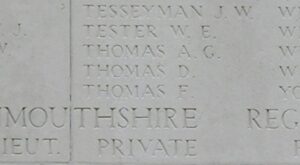
David Thomas, Stoker 2nd Class, K/51445, Royal Navy. David was born at Llangadog on 19 May 1894, the son of Evan and Dinah Thomas. By 1911 the family had moved to 23, Villiers Road, Ammanford. David served in the Royal Navy, and was based at their shore base at Chatham, HMS Pembroke. He became ill and died of disease on 20 May 1918, aged 24. David is buried at Llangadog Church Cemetery. He does not appear to be commemorated locally.
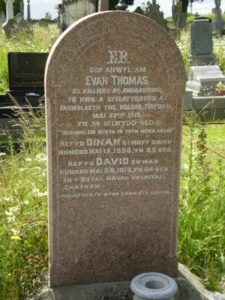
David Edward Thomas, Corporal, 56905, Welsh Regiment. David was the son of Edward and Sarah Thomas, of Ivy Cottage, Llangadog, and enlisted into the Pembroke Yeomanry. He later transferred into the 13th Battalion, the Welsh Regiment, 114 Brigade, 38th (Welsh) Division. The Division had been in France since landing during December, 1915, and had fought in Flanders, on the Somme at Mametz Wood, and then at Third Ypres, and in 1918 were rushed from their winter post of Armentieres to aid with the desperate defence of the Somme area, based around Albert. After the tide of war had turned, after the Allied victory at Villers-Brettoneux on 8 August 1918, the Allies went on the offensive, and swiftly moved towards the mighty Hindenburg Line. It was during the Battle of Epehy, which was to provide the launching pad for the assault on the Hindenburg Line, that David was killed in action on 19 September 1918, aged 26. He is buried at Gouzeaucourt New British Cemetery, France. (David is commemorated on the Gosen Chapel Memorial).
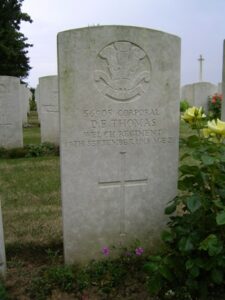
John Thomas, Private, 202821, Welsh Regiment. John was born near Llangadog, the son of John and Jane Thomas. The family had moved to Ystradowen, Cwmllynfell prior to 1911. John worked at the Cwmllynfell Colliery prior to enlisting at Carmarthen into the 4th Battalion, Welsh Regiment, which was the local Territorial infantry battalion, and was attached to 159 Brigade, 53rd (Welsh) Division. The Division had fought through a hard campaign in Gallipoli from August, 1915 until they were evacuated, and then fought in the Palestinian theatre, where they helped in the capture of Jerusalem. John had taken ill sometime during the campaign, and had arrived back in England for treatment, but sadly died in hospital at Reading on 28 December 1917, aged 36. He is buried in Cwmllynfell Welsh Congregational Chapelyard. John is commemorated at Cwmllynfell, but not at Llangadog.
William Rees Ceidrych Thomas, Lance Corporal, 10007, Canadian Infantry. William was born on 29 September 1882, the son of Thomas and Mary Thomas, of Dolgoy, Llangadog. The family later moved to Holsty, Vowchurch, Hereford, but William went his own way, and emigrated to Canada in 1910. He enlisted at Edmonton on 29 June 1915 into the 8th Battalion (Winnipeg), Canadian Expeditionary Force. William embarked for the Western Front via England, and joined his battalion in France where it was part of the 2nd Brigade, 1st Canadian Division. He would have taken part in the Battle of Mount Sorrel in June 1916, and then moved with the Canadians to the Somme. William was killed during the Battle of Flers-Courcelette on 19 September 1916. He was 34 years old, and is commemorated on the Vimy Memorial, France. William doesn’t appear to be commemorated locally.
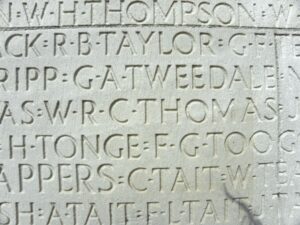
World War Two, 1939-1945
Ifor Pershing Davies, Fireman & Trimmer, Merchant Navy. Ifor was born on 15 September 1919, the son of Henry and Annie Davies, of Llangadog. He served in the Merchant Navy aboard the Cardiff registered steamer SS Ruperra. The ship was sailing as part of Convoy HX-79, when she was sunk by the German Submarine U-46 on 19 October 1940. Ifor was killed in the sinking aged just 21, and is remembered on the Tower Hill Memorial, London. (‘Pershing’ is commemorated on the Church Memorial).
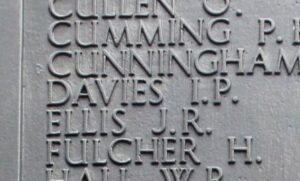
Baron John Frederick Foley De Rutzen, Major, 72466, Welsh Guards. John was the only son of Baron Alan Frederick James de Rutzen, and Baroness Eleanor Etna Audley de Rutzen, of Ridgeway, Pembrokeshire. He married Sheila Victoria Katrin Philipps prior to the war, and the couple resided at Picton Castle. John was commissioned into the Welsh Guards, becoming a Major with the 3rd Battalion, Welsh Guards. The battalion was an armoured unit, and fought in the North African campaign. In 1944 it took part in the invasions of Sicily and Italy. Alan was mortally wounded whilst leading a platoon on the Bataglia Ridge, and died on 11 October 1944, aged 36. He is buried at Santerno Valley War Cemetery, Italy. John does not appear to be commemorated locally, but at Minwear in Pembrokeshire.
David Alvin Lloyd Edwards, Navigator II, 1656102, Royal Air Force Volunteer Reserve. David was the son of David Thomas Edwards and Margaret Ann Edwards, of Leicester House, Llangadog. He served as a Navigator with 115 Squadron, Royal Air Force, which was a heavy bomber unit, based at RAF Stradishall, and equipped with the Avro Lancaster III. David survived the war, but was found dead on MOD land at Buckenham Tofts, Stanford, Swaffham, Norfolk on 11 November 1947, aged 23. He is buried at Llangadog Church Cemetery. (Alvin is commemorated on the Gosen Chapel Memorial).
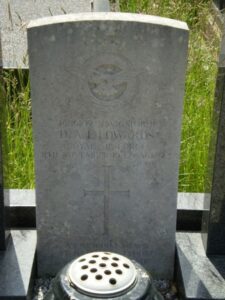
Morgan Gwyn Hughes, Private, 13072700, Pioneer Corps. Morgan was the son of Joseph and Mary Hughes, of Glandyrfal, Llangadog. He served with the Pioneer Corps. Little is known of Morgan’s service, but he died at Stoke Military Hospital, Devonport on 19 January 1941, aged 29, and is buried at Twynllanan Methodist Chapelyard. (Morgan is commemorated on the Gosen Chapel Memorial and in the Church).
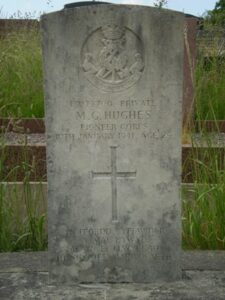
Frederick Norman Jackson, Sergeant, 972564, Royal Air Force Volunteer Reserve. Norman was born in 1917, the son of Albert Frederick and Elsie Clara Jackson, of Llangadog. He was educated at Llandovery Grammar School. At the outbreak of war he enlisted into the Royal Air Force Volunteer Reserve. After training as a Wireless Operator/ Air Gunner, he was posted to 10 Squadron, RAF, which was equipped with Armstrong Whitworth Whitley bombers by the outbreak of the Second World War. On 16 April 1941, Norman was aboard Whitley Mk V, Serial Z6557, which took off from RAF Leeming in Yorkshire, bound for Bremen, Germany, as part of a force of 107 heavy bombers. At around 22.40 that night, the Whitworth crashed into the sea near the Dutch Coast, killing all of her crew. Norman was 23 years old, and is buried alongside his former crew-men at Sage War Cemetery, Germany. (‘Norman’ is commemorated on the Church Memorial). His younger brother Keith was killed in Palestine in 1947.
Keith Jackson, Trooper, 19066756, Royal Armoured Corps. Keith was born on 11 July 1928, the son of Albert Frederick and Elsie Clara Jackson, of Llangadog. He was too young to have served during the war, but enlisted into the 4th/7th Royal Dragoon Guards, which was an armoured reconnaissance unit. The 4th/7th Dragoons had served at Dunkirk in 1940, then in North Africa and Italy. It was then brought back to Britain, and took part in the Normandy Landings in June 1944. The regiment ended the war in Bremerhaven, and a year later was deployed to Palestine for a tour of duty lasting from 1946-1948. Gwyn served in Palestine, but became ill and died after a long spell in hospital in Jerusalem on 18 September 1947, aged 19. He is buried at Ramleh War Cemetery, Israel. Keith doesn’t appear to be commemorated locally, although his brother Norman is.
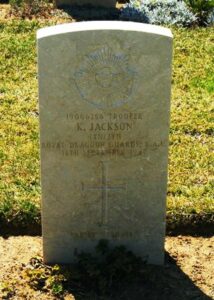
William Ronald Perkins, Sapper, 14374282, Royal Engineers. William was the son of John Alister Perkins and Sarah Perkins, of Llwyncelyn, Llangadog. He married Hannah Mary Walters at Carmarthen in 1935 and the couple lived in Llangadog. William served in the Royal Engineers, in the 703rd Artisan Works Company. The Company was formed from men with experience of road building, and were used for the building of airfields and roads for the British Forces. William died near Bromsgrove on 8 November 1945, aged 36, and is buried at Llangadog Church Cemetery. (‘Ronald’ is commemorated on the Church Memorial).
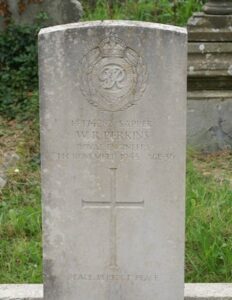
Frederick Iryl Price, Private 14215427, South Staffordshire Regiment. Frederick was the son of John and Catherine Ann Price, of Llangadog, and served in the 1st Battalion, South Staffordshire Regiment. The Battalion had been selected to join the second Chindit operation which took place between March and July 1944. This involved six groups of brigade equivalence, in effect, a division’s worth of troops. 1st South Staffords operated under Brigadier Calvert in 77 Brigade, landing at Broadway, establishing the famous block at White City and supporting 111 Brigade in another block at Blackpool. These codewords were for features or areas which once captured and held, prevented the movement of Japanese troops and supplies to oppose the main Allied advance through Burma. Finally, combined with Chinese troops, they captured Mogaung, one of the two Allied objectives laid down at the Quebec Conference and materially assisted in the capture of the other (Myitkyina). These victories were gained at terrible cost. 1st South Staffords had air-landed in WACO gliders with roughly 830 men and were reinforced during the campaign (March to August 1944) with about eighty more men. They lost 150 killed and more than 250 wounded, disease led to a further 180 men being evacuated. Frederick was killed during the campaign in Burma on 12 June 1944 and is remembered on the Rangoon Memorial, Myanmar. He was just 20 years old. Frederick does not appear to be commemorated locally.
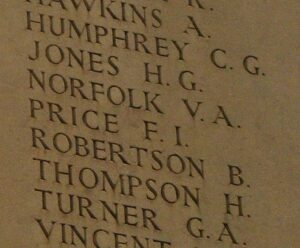
David John Wood, Stoker 1st Class, D/KX 137365, Royal Navy. David was born on 25 September 1922, the son of William and Edith E. Wood, of Llangadog. He served in the Royal Navy aboard H.M. Submarine P. 64 ‘Vandal’. Vandal had joined the Third Submarine Flotilla in Holy Loch, Scotland, when she left her anchorage on 24 February 1943 to undergo a three-day trial. Vandal mysteriously disappeared together with her crew of 37 men while on the first day of her trials, and was not seen again until her wreck was discovered in 1994 off the coast of Arran. David died in the sinking of the Vandal on 24 February 1943. He was 20 years old, and is remembered on the Plymouth Naval Memorial, Devon. During 1997 a memorial to those lost aboard HMS Vandal was erected beside the Caledonian MacBrayne ferry terminal at Lochranza Pier, Isle of Arran. (‘Daff’ is commemorated on the Church Memorial).
